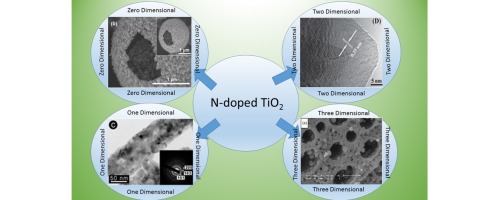Journal of Photochemistry and Photobiology C: Photochemistry Reviews ( IF 12.8 ) Pub Date : 2016-05-19 , DOI: 10.1016/j.jphotochemrev.2016.05.001 Shahzad Abu Bakar , Caue Ribeiro

|
TiO2 material has gained attention as the most studied semiconductor material for photocatalytic purposes, including their use in devices for clean energy production, such as solar cells and water splitting systems. However, the wide band gap of this material limits applications to UV light, which also confines the use of solar irradiation as the energy source. Much research in the last years is showing the ability of N doping into TiO2 to promote light absorption in the visible range but, to date, it is still controversy if this doping is beneficial to the photocatalytic process, as well as the synthetic methods are not well stabilized yet. Then, this paper summarizes the recent advancement in the structural design perspective of N-doped TiO2 photocatalyst, in a critical analysis of its application for environmental purposes. We reported the dimensionality effect associated with modified N-doped TiO2 structure for its characteristics properties and photocatalytic performance; counting more specifically its charge transportation, surface area, adhesion, reflection and absorption properties. A concise view of the doping effect over morphology in 0, 1, 2 and 3-dimensional ranges was provided, in order to understand which effects are also occurring on the materials besides the photocatalytic response. Furthermore, selected recent and significant advances in the area of renewable energy applications for modified N-doped TiO2 were assessed with the particular importance given towards the electricity generation by dye-sensitized solar cells and lithium-ion batteries rechargeable for electric energy storage.
中文翻译:

氮掺杂二氧化钛:材料设计和尺寸对现代应用的影响的概述
TiO 2材料作为用于光催化目的的研究最多的半导体材料已受到关注,其中包括将其用于清洁能源生产的设备中,例如太阳能电池和水分解系统。但是,这种材料的宽带隙限制了UV光的应用,这也限制了将太阳辐射用作能源。近年来的许多研究表明,向TiO 2中掺杂N能够促进可见光范围内的光吸收,但是迄今为止,这种掺杂是否对光催化过程有益,以及合成方法是否尚存争议。尚未很好地稳定下来。然后,本文总结了N掺杂TiO 2在结构设计方面的最新进展。光催化剂,在对环境应用的严格分析中。我们报道了改性N掺杂的TiO 2结构的尺寸特性及其特性和光催化性能。更具体地计算其电荷传输,表面积,附着力,反射和吸收特性。提供了在0、1、2和3维范围内对形貌的掺杂效应的简明视图,以便了解除了光催化反应之外,还对材料产生了哪些效应。此外,在改性N掺杂的TiO 2的可再生能源应用领域中,一些最新的重要进展 评估对染料敏化太阳能电池和可充电以存储电能的锂离子电池对发电具有特别重要的意义。









































 京公网安备 11010802027423号
京公网安备 11010802027423号